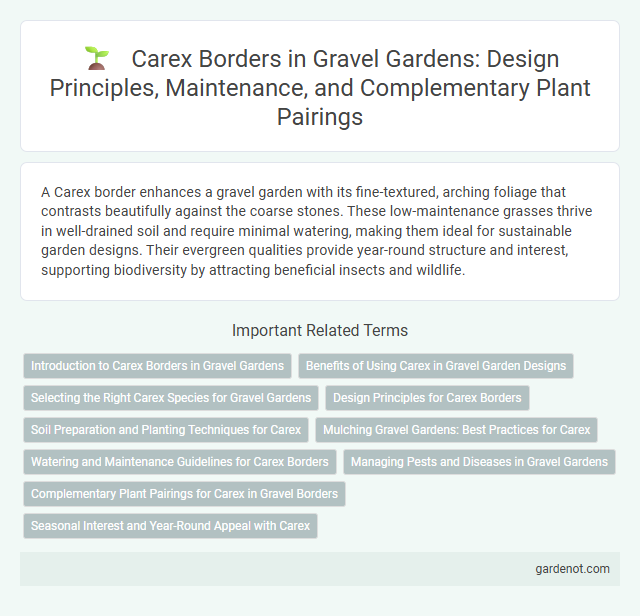A Carex border enhances a gravel garden with its fine-textured, arching foliage that contrasts beautifully against the coarse stones. These low-maintenance grasses thrive in well-drained soil and require minimal watering, making them ideal for sustainable garden designs. Their evergreen qualities provide year-round structure and interest, supporting biodiversity by attracting beneficial insects and wildlife.
Introduction to Carex Borders in Gravel Gardens
Carex borders in gravel gardens offer a low-maintenance, visually appealing solution that thrives in well-drained, nutrient-poor soils typical of gravel settings. These ornamental grasses provide year-round texture and movement, supporting biodiversity by attracting pollinators and beneficial insects. Their erosion control properties and adaptability to partial shade or full sun make Carex an ideal choice for sustainable gravel garden design.
Benefits of Using Carex in Gravel Garden Designs
Carex enhances gravel garden designs by providing year-round texture and contrast with its fine, arching foliage that complements the coarse gravel surface. Its drought tolerance and low maintenance requirements make it an ideal choice for sustainable landscaping, reducing water usage and upkeep efforts. The plant's dense growth habit stabilizes soil and suppresses weeds, promoting a healthier and more attractive gravel garden environment.
Selecting the Right Carex Species for Gravel Gardens
Selecting the right Carex species for gravel gardens involves choosing varieties that thrive in well-drained, porous soil and tolerate drought conditions. Species such as Carex elata 'Aurea' and Carex morrowii 'Ice Dance' offer vibrant foliage contrasting beautifully against gravel textures. Prioritize low-maintenance, adaptable Carex types to ensure long-lasting structure and year-round interest in gravel garden borders.
Design Principles for Carex Borders
Carex borders thrive when designed with layered textures and varying heights, creating visual depth and natural movement. Incorporating contrasting foliage colors and integrating durable mulch enhances moisture retention and weed suppression. Strategic spacing promotes air circulation, reducing disease risk while ensuring each plant reaches full aesthetic potential.
Soil Preparation and Planting Techniques for Carex
Carex thrives best in well-drained, moist soil enriched with organic matter to mimic its natural habitat. Before planting, loosen the soil to a depth of 12 inches and incorporate compost or aged manure to improve fertility and structure. Space Carex plants 12 to 18 inches apart, ensuring crown-level planting to prevent rot and promote vigorous growth in gravel garden borders.
Mulching Gravel Gardens: Best Practices for Carex
Mulching gravel gardens with organic materials such as bark or leaf litter around Carex borders helps retain soil moisture and suppress weeds without disrupting the plant's natural drainage needs. Applying a 2-3 inch layer of mulch promotes healthy root development and maintains the aesthetic contrast between the fine-textured Carex foliage and the gravel base. Regularly refreshing the mulch supports sustainable soil health, essential for the long-term vigor of Carex in gravel garden landscapes.
Watering and Maintenance Guidelines for Carex Borders
Carex borders thrive best with consistently moist, well-drained soil, requiring regular watering to prevent drought stress, especially during dry spells. Mulching around the base helps retain soil moisture and suppress weeds, while occasional trimming removes dead foliage to encourage fresh growth. Monitoring for pests and diseases ensures the health of Carex plants, promoting a dense, attractive border in gravel garden settings.
Managing Pests and Diseases in Gravel Gardens
Carex borders in gravel gardens require vigilant monitoring to prevent infestations of aphids and spider mites, which thrive in dry, well-drained conditions. Implementing natural predators like ladybugs and using insecticidal soaps can effectively control pest populations without disrupting the garden's ecological balance. Regular pruning of damaged foliage and improving air circulation around Carex clumps reduces the risk of fungal diseases such as rust and leaf spot.
Complementary Plant Pairings for Carex in Gravel Borders
Carex thrives alongside drought-tolerant species such as lavender, sedum, and eryngium in gravel garden borders, creating a visually appealing and resilient planting scheme. Its fine-textured foliage contrasts beautifully with the spiky forms of eryngium and the fleshy leaves of sedum, enhancing the overall structure and seasonal interest of the border. Combining Carex with deep blue lavenders enriches the color palette while supporting pollinators in well-drained gravel soils.
Seasonal Interest and Year-Round Appeal with Carex
Carex borders deliver exceptional seasonal interest by showcasing graceful texture and foliage color shifts from spring through winter, enhancing gravel gardens with dynamic visual appeal. These hardy, low-maintenance sedges thrive in well-drained soil, maintaining structure and vibrancy even during dry summer months and cold winters. Their evergreen or semi-evergreen habits provide year-round greenery, supporting garden continuity and biodiversity throughout all seasons.
Carex border Infographic

 gardenot.com
gardenot.com